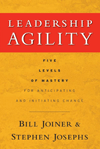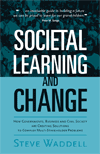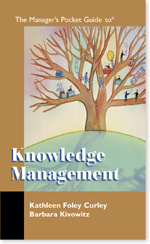|
"Leadership Agility" – helps you assess your current level of agility and provides a roadmap that shows you how to move to the next level in your development as an agile leader. "Making the Business Case for EHS" – provides eight tactics to ensure management buy-in for your EHS initiatives "Societal Learning and Change: How Governments, Business and Civil Society are Creating Solutions to Complex Multi-Stakeholder Problems" – offers lessons learned from bringing about change in response to globalization, sustainability, and inequity "The Manager's Pocket Guide to Knowledge Management" – a practical roadmap to leveraging your company’s knowledge into its competitive advantage "From Disconnect to Dialogue: Transforming Business Results through Pivotal Conversations" – reveals how changes in management behavior and attitude led to a business turnaround "Leadership for Organizational Learning" – offers working principles for building an agile and continual learning organization |
 |
Leadership Agility: Five Levels of Mastery for Anticipating and Initiating
Change Leadership agility is the master competency needed for sustained success in today's complex, fast-paced business environment. Richly illustrated with stories based on original research and decades of work with clients, this groundbreaking book identifies five levels that leaders move through in developing their agility. Only 10% of today's managers have mastered the level of agility needed for consistent effectiveness in the turbulent era of global competition. Significantly, one of the common characteristics of these highly agile leaders is a strong personal commitment to corporate responsibility. Written in an engaging, down-to-earth style, Leadership Agility is your personal guide to leadership agility in action. After describing and illustrating the four key competencies of agile leaders, Bill Joiner and Stephen Josephs use real-life stories and examples to provide a clear road map that shows you how to bring these competencies to new levels. Reading this book will confirm your best instincts and introduce you to new forms of leadership currently practiced by only a small percentage of highly agile leaders. |
 |
Making the Business Case for EHS Before you can effectively manage the environment, health, and safety (EHS) function, you must convince management that your activities produce business value. This practical new handbook – Making the Business Case for EHS – is written by Robert B. Pojasek, Ph.D. an international authority on process development and Adjunct Professor at Harvard University. He lays out the concrete steps that EHS (environmental health and safety) managers must take to get support for their environmental initiatives. This BLR guidebook also helps EHS managers align processes and systems with the goals of senior management, and translate initiatives into bottom line results. This book highlights 10 principles that will guide you, along with 8 tactics you can use to implement your EHS activities. Three case studies explain in step-by-step detail how an autobody refinishing operation, a paint manufacturer, and an outboard motor company translated these principles into management support for EHS. |
 |
Societal
Learning and Change: How Governments, Business and Civil
Society are Creating Solutions to Complex Multi-Stakeholder Problems CONSTRUCTING ROADS in Madagascar; forestry along Canada’s Pacific
Coast; water and sanitation projects in South Africa; community banking
in the United States; constructing a new global system for corporate
reporting. These all have something in common. They provide great illustrations
of the types of profound and wise changes needed in the way we run our
affairs if we are to respond to the scale of environmental and social
challenges and opportunities facing us. They are examples of ‘societal
learning and change’. Today, this phenomenon is occurring across
industries as diverse as resources extraction, infrastructure development,
agriculture and information technology at the local, national, regional
and global levels. Its essence involves the ability to create rich relationships
that bridge large differences. This book describes this phenomenon for
practitioners to help them address issues and develop opportunities more
effectively. Read more > |
 |
The Manager's Pocket Guide to Knowledge Management
Knowledge—about customers, markets, core processes, how things get done, who knows what—is a core business asset. You may have heard of knowledge management. No longer a buzz word, it’s becoming mainstream in companies large and small who want to strengthen core competencies in:
If you’re ready to start the knowledge management process in your
organization, this book provides a practical plan and roadmap. You’ll
walk through all the stages—assessment, planning, deployment, and
evaluation—and gain specific action steps for putting it all together
to expand your core competency and win competitive advantage. Order this
book > |
 |
From Disconnect to
Dialogue: Transforming Business Results through Pivotal Conversations The story of a management group in a software company who transformed
themselves and their business through a new approach to pivotal business
conversations. Provides a detailed, inside view of the experiential
learning process used in Pivotal
Conversations workshops. Shows how new attitudes and behaviors
led to a business turnaround. |
| Leadership for Organizational Learning by Bill Joiner Outlines a set of working principles for leaders to use in developing organizations that are continually learning and adapting to rapidly changing conditions. Published in John Adams (ed.), Transforming Leadership, a book of readings by thought-leaders in the field of organization transformation, including Linda Ackerman Anderson, Ronnie Lessem, and Peter Senge. Order this book > |
|
|


